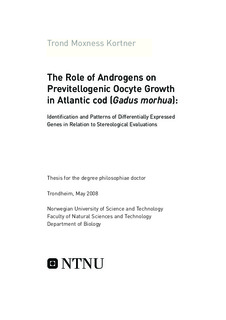| dc.contributor.author | Kortner, Trond Moxness | nb_NO |
| dc.date.accessioned | 2014-12-19T13:11:21Z | |
| dc.date.available | 2014-12-19T13:11:21Z | |
| dc.date.created | 2008-06-02 | nb_NO |
| dc.date.issued | 2008 | nb_NO |
| dc.identifier | 124567 | nb_NO |
| dc.identifier.isbn | 978-82-471-1002-7 | nb_NO |
| dc.identifier.uri | http://hdl.handle.net/11250/244604 | |
| dc.description.abstract | The internal signals that regulate fecundity are generally not well described. Overt developmental and/or functional changes are controlled at the molecular and cellular levels of biological organization. Therefore, changes in gene expression profile as a result of hormonal exposure and the subsequent molecular processes that lead to developmental, functional and physiological changes may be used as quantitative molecular markers for cellular, physiological, developmental and reproductive effects in an organism. Additionally, the identification of hormonal responsive genes and their expression patterns as a result of hormonal influence are of vital importance in order to shed light on the underlying mechanisms of these fundamental processes of reproduction.
Despite the fact that hormonal effects on the growth of previtellogenic oocytes might involve several cascades of physiological events, observations in fish and mammals point to a pivotal role of androgens. The objectives of the present work implied the identification and sequencing of a number of androgen responsive genes in the previtellogenic Atlantic cod (Gadus morhua) ovary using the analytical power of suppressive subtractive hybridization (SSH). Subtracted clones were arrayed, preserved and applied in gene expression profiling.
The present study demonstrates, for the first time, that androgens (particularly the nonaromatizable androgen, 11-ketotestosterone; 11-KT) can induce ovarian development in immature female Atlantic cod, adding further evidence to our hypothesis that androgens are involved in the regulation of previtellogenic oocyte growth and development in this species. In general, both 11-KT and testosterone (T) are capable of inducing oocyte growth, with the former hormone being the strongest modulator. In addition, we also presented the identification, sequencing and the expression patterns of a number of androgen responsive transcripts in the previtellogenic cod ovary. A targeted cod array (CodArray) consisting of subtracted clones with unique expression patterns that were either up or down regulated, after in vitro androgen exposure of previtellogenic ovarian tissues was constructed. The parallel expression patterns of candidate genes involved in steroidogenesis and oocyte growth control, add further information on how androgenic action may produce advances in previtellogenic oocyte growth. We believe the novel roles of androgens as promoters of ovarian growth and development presented in this study will be beneficial for the aquaculture industry and for breeding of new captive and endangered species. It can also form the basis for the development of useful models in fisheries management. Differentially expressed genes may form an integral link with quantifiable environmental variables (e.g. food availability and growth rates). In general, our findings form the basis for generating more hypotheses for further detailed studies and for deduction of evolutionary relatedness in androgen control of early oocyte growth in vertebrates. Therefore, these findings may have significant economic benefit for predictive ecological models, particularly with respect to the noticeable and worldwide declining cod stock. | nb_NO |
| dc.language | eng | nb_NO |
| dc.publisher | Fakultet for naturvitenskap og teknologi | nb_NO |
| dc.relation.ispartofseries | Doktoravhandlinger ved NTNU, 1503-8181; 2008:163 | nb_NO |
| dc.relation.haspart | Kortner, Trond Moxness; Rocha, Eduardo; Silva, Paula; Castro, Filipe C.; Arukwe, Augustine. Genomic approach in evaluating the role of androgens on the growth of ^ Atlantic cod 2 (Gadus morhua) previtellogenic oocytes. Comparative Biochemistry and Physiology, Part D, 2008. | nb_NO |
| dc.relation.haspart | Kortner, Trond Moxness; Arukwe, Augustine. Effects of 17α-methyltestosterone exposure on steroidogenesis and cyclin-B mRNA expression in previtellogenic oocytes of Atlantic cod (Gadus morhua). Comparative Biochemistry and Physiology, Part C. 146: 569-580, 2007. | nb_NO |
| dc.relation.haspart | Kortner, Trond Moxness; Arukwe, Augustine. The xenoestrogen, 4-nonylphenol, impaired steroidogenesis in previtellogenic oocyte culture of Atlantic cod (Gadus morhua) by targeting the StAR protein and P450scc expressions. General and Comparative Endocrinology. 150: 419-429, 2007. | nb_NO |
| dc.title | The Role of Androgens on Previtellogenic Oocyte Growth in Atlantic cod (Gadus morhua):: Identification and Patterns of Differentially Expressed Genes in Relation to Stereological Evaluations | nb_NO |
| dc.type | Doctoral thesis | nb_NO |
| dc.contributor.department | Norges teknisk-naturvitenskapelige universitet, Fakultet for naturvitenskap og teknologi, Institutt for biologi | nb_NO |
| dc.description.degree | PhD i biologi | nb_NO |
| dc.description.degree | PhD in Biology | en_GB |

